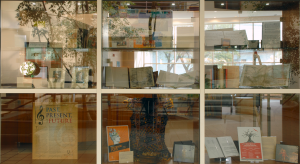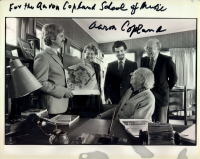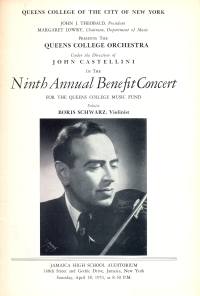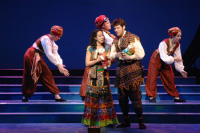| |
About the Exhibit
This inaugural exhibit of the Music Library display cases traces the rich history of the Aaron Copland School of Music from its beginnings as one of the earliest departments on campus through the school’s continued efforts to foster and support music in today’s rapidly changing world.
 Established within the first year Queens College was open, the music department quickly grew into one of the most distinguished in the country with graduates becoming chairs at Harvard, Princeton, and Yale; successful Broadway composers; as well as thriving performers, music editors, and accomplished school music teachers. The original curriculum, though it has been modified as needed, remains the cornerstone of the school’s successful training. Initially only offering bachelor’s degrees, master’s degrees were introduced during the 1960s along with undergraduate and graduate performance degrees. The department of music became the Aaron Copland School of Music in 1981, and, in 1991, the school moved into the current Music Building, designed especially for the school, including the Lefrak Concert Hall and world-class organ. In addition to the well-established programs, the Aaron Copland School of Music is now also home to a thriving graduate program in jazz and a rapidly growing opera program. Established within the first year Queens College was open, the music department quickly grew into one of the most distinguished in the country with graduates becoming chairs at Harvard, Princeton, and Yale; successful Broadway composers; as well as thriving performers, music editors, and accomplished school music teachers. The original curriculum, though it has been modified as needed, remains the cornerstone of the school’s successful training. Initially only offering bachelor’s degrees, master’s degrees were introduced during the 1960s along with undergraduate and graduate performance degrees. The department of music became the Aaron Copland School of Music in 1981, and, in 1991, the school moved into the current Music Building, designed especially for the school, including the Lefrak Concert Hall and world-class organ. In addition to the well-established programs, the Aaron Copland School of Music is now also home to a thriving graduate program in jazz and a rapidly growing opera program.

Karol Rathaus, a composer and refuge from Nazi Germany for whom the first music building was named for, skillfully led and developed the department during the early years. Saul Novack began the music theory department’s long-standing emphasis on the analytical system of Hienrich Schenker, a tradition that continues today with Mark Anson-Cartwright, David Gagné, and William Rothstein. Novack, with fellow faculty member Barry Brook, created the doctoral program in music at the Graduate Center of CUNY. Rathaus, Novack, Brook, and their colleagues (including Sol Berkowitz, Gabriel Fontrier, Leo Kraft, and Boris Schwarz) established the curriculum, high standards, and a commitment to collaborations between students and faculty, for which the school remains known for today.
Students from all over the world come to study with present faculty members, which includes a number of Fulbright and Guggenheim Award recipients, one of Leonard Bernstein’s assistant conductors with the New York Philharmonic (Maurice Peress), Grammy award winners (Michael Mossman and Antonio Hart), and world-renowned scholars, educators, performers, composers, and conductors. Recent alumni have gone on to earn graduate degrees in performance from Juilliard; in musicology from Harvard, Columbia, Cornell, and Stanford; and in theory from Yale.
 Current students, who represent the future of music and the Aaron Copland School of Music,study and perform with Queens College and visiting faculty, such as 2010 distinguished artist-in-residence Bright Sheng; perform in professional quality instrumental, vocal, and jazz ensembles and opera productions; and complete a rigorous academic and musicianship curriculum. Among our 2010 graduates are accomplished public school music teachers, talented performers, students entering composition graduate programs at the University of Michigan and the New England Conservatory of Music, and budding scholars. Current students, who represent the future of music and the Aaron Copland School of Music,study and perform with Queens College and visiting faculty, such as 2010 distinguished artist-in-residence Bright Sheng; perform in professional quality instrumental, vocal, and jazz ensembles and opera productions; and complete a rigorous academic and musicianship curriculum. Among our 2010 graduates are accomplished public school music teachers, talented performers, students entering composition graduate programs at the University of Michigan and the New England Conservatory of Music, and budding scholars.
Eleanor Roosevelt said, “the future belongs to those who believe in the beauty of their dreams.” With the dedication, enthusiasm, and joy of students, alumni, and faculty of the Aaron Copland School of Music, the future will be full of beautiful music and fulfilled dreams.
|
|